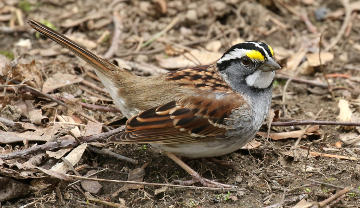Village News

PHOTO COURTESY OF GARRY KESSLER
White-throated sparrow (white-striped type)
September 18, 2020, Page A3
NATURE NOTES
By Annie Reid
Westborough Community Land Trust
Interesting white-throated sparrows pass through soon
Besides crisp, sunny days and fall colors, the joys of autumn include the chance to see migrating birds that usually pass through here only in fall and spring. Many are sparrows, often looking inconspicuous and all-alike from a distance, but you might see or hear a fairly distinctive one, the white-throated sparrow.
Or perhaps you could think of it as two. You can identify white-throated sparrows (Zonotrichia albicollis) by the bright white throat that gives them their name, but they come in two color schemes, white-striped and tan-striped. Look at their heads. White-striped birds have white and black stripes on their heads, which are easier to pick out in a crowd of sparrows pecking at spilled seed under a birdfeeder. Tan-striped birds have tan and brown stripes on their heads, which blend well into a crowd and the surroundings. Both types have yellow between the eye and beak, and both look a bit larger and perhaps puffier than other sparrows in a mixed flock. Adults are duller in fall than in spring. In juveniles, the white throat is grayish.
You’re probably used to seeing males and females of certain bird species looking different, especially in the spring breeding season when males are colorful and females remain drab. But that’s not what’s going on with white-throats (as they’re called for short). You can’t tell the sex by the stripes on their head. A white-striped bird could be either male or female, and a tan-striped bird could be either male or female.
Surprisingly, in the breeding season, pairs almost always form between a white-striped bird and a tan-striped bird. Apparently, opposites attract in this unusual way. White-striped males and tan-striped females pair up, as do tan-striped males and white-striped females. Pairs produce both white-striped and tan-striped offspring. Of course, we don’t get to see this around here, because these sparrows breed across Canada and farther north in New England (high on Mt. Washington, N.H.) and west in Massachusetts.
What causes the differences between the white-striped and tan-striped birds? The answer lies in their genes, specifically those on the birds’ second chromosome pair. And different genes lead to differences in behavior between the two types, probably due to genetically influenced differences in hormone levels. For example, white-striped birds tend to be more aggressive, and tan-striped birds tend to give more parental care. Researchers find that all females tend to prefer tan-striped males, and all males tend to prefer white-striped females. On the breeding grounds, the white-striped females quickly pair with all the tan-striped males, and then the remaining tan-striped females and white-striped males pair up.
When it comes to birdsong, all the males sing, and white-striped females also sing. The whistled song is clear and simple, often with two long tones and three triplets. Some people like to remember it as “Old-Sam-Peabody-Peabody-Peabody” or “Oh-sweet-Canada-Canada-Canada.” White-throats sing year-round, even when migrating, so you might hear their song between mid-September and mid-November (and during April migration).
This year white-throated sparrows were in the news because of a change in their song that has been sweeping through their populations – like a virus – in recent years. What’s the change? White-throats have been omitting the third note of the final triplets of their song, changing the repeated “Peabody” or “Canada” to a more staccato “Peabod” or “Cana”. (You might be able to hear the slight difference at https://youtu.be/XJ98hPcRARE.)
Researchers first noticed the change in far western Canada in 2000. They tracked its movement eastward through breeding populations in Canada, and it’s now arriving in the east. Apparently, the birds pick up the changed version from one another on their wintering grounds in the southeastern U.S., where birds from different parts of Canada mix. Why has this change gone viral? Nobody knows.
In the weeks ahead, and again next April, have fun looking and listening for white-throats at birdfeeders and shrubby woodland edges.
Date index
Month (September)
Common name index
Scientific name index
Category index